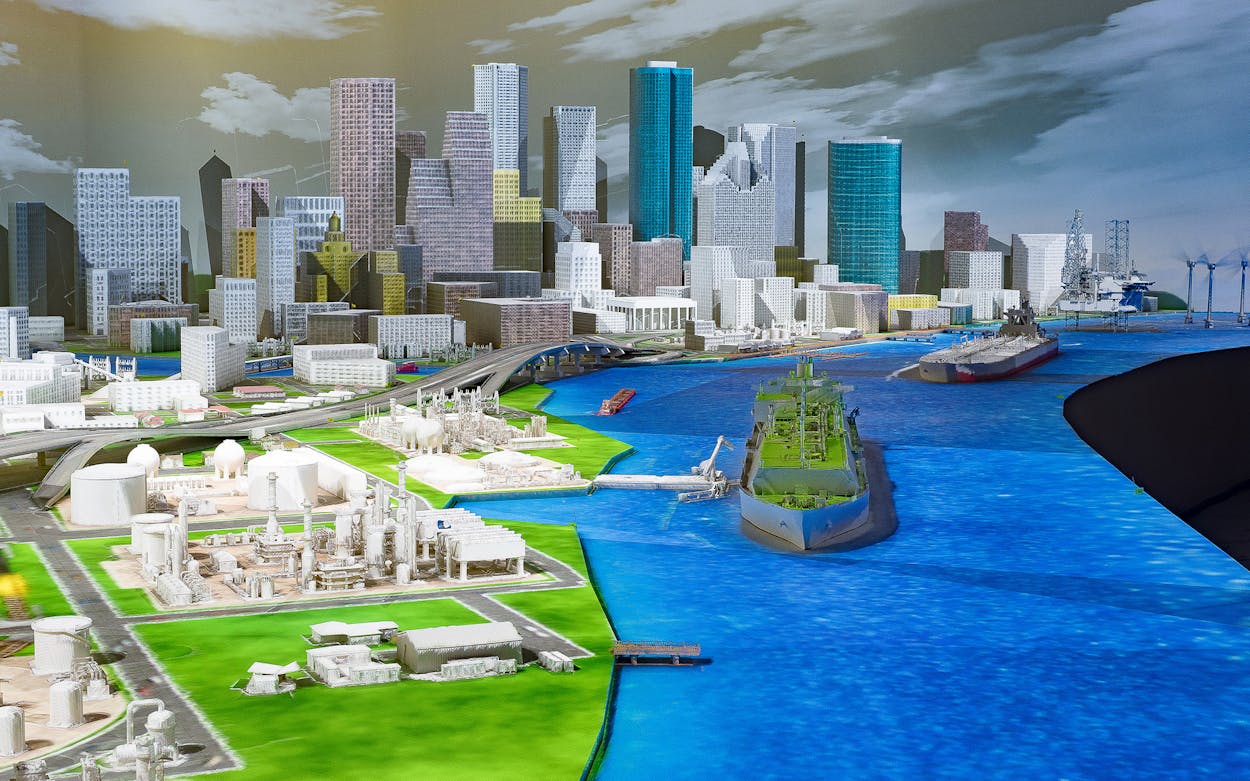For years, the section of the Houston Museum of Natural Science devoted to oil and gas exploration was rudimentary: a wall mural depicting a geological cross-section of Southeast Texas, a table with a couple of sample drill bits, and scale models of a few drilling rigs. In 1994 the museum hired a former naval officer named Paul Bernhard to design the Wiess Energy Hall, an 8,500-square-foot permanent exhibition featuring cutting-edge touch-screen computer monitors and the “Geovator,” a mock elevator that used pneumatic airbags and computer animation to simulate the effect of descending into the earth.
The energy hall quickly became one of the museum’s most popular attractions, visited by millions of people and countless school groups. In 2005 the hall received a facelift, with updated information and new, flat-screen plasma monitors. Three years ago, at the height of the unconventional oil and gas revolution spurred by new hydrofracking technology, the museum decided that a more radical update was needed, so it launched a $40 million fundraising campaign to build a brand-new permanent exhibition, informally dubbed Wiess Energy Hall 3.0.
The new hall opens to the public today, and visitors will have no trouble seeing where all that money has gone. At 30,000 square feet, Wiess 3.0 is more than three times larger than the original hall and features a dizzying array of high-tech installations devoted to all aspects of the modern-day energy industry, from hydrofracking to deep-sea drilling to alternative energies. The drill bits from the museum’s early display are still on view in a corner of the hall, but they’re overwhelmed by a cacophony of flashing, beeping, and rumbling machines.
There’s a new, larger Geovator that can accommodate twenty people. The Eagle Ford Shale Experience is a Universal Studios–esque “Four-Dimensional Theater” that takes up to 42 visitors at a time on a bumpy, simulated ride into an abandoned South Texas oil well being fracked with water and chemicals. Perhaps the most eye-catching exhibit is “Energy City,” a 2,200-square-foot, 1:150 model designed to illustrated the “energy value chain,” including oil fields, oil tankers, nuclear power plants, and wind turbine farms. The tableau is brought to life by state-of-the-art projection mapping technology employing 32 computer-programmed projectors.
Virtually every major energy company with a Houston presence—including ExxonMobil, Chevron, Shell, and ConocoPhillips—contributed money to the hall, and many of them also consulted on its content, so it’s no surprise that most of the exhibits are industry-friendly. One of the largest galleries is dedicated to “The Unconventional Hydrocarbon Revolution” and features an interactive computer game called “Can You Frack It?” A different gallery features a computer game in which visitors win points for extracting the most oil at the lowest cost using directional drilling. The game is sponsored by the Marathon Oil Corporation.
One gallery is devoted to renewable energy, with educational installations about solar, wind, and geothermal power. The threat of global warming is addressed by a row of touchscreen monitors that display images of melting glaciers alongside text warning that hydrocarbon energy “is both finite and unsustainable at our current rate of consumption.”
“We provide the scientific facts,” said Houston Museum of Science president and CEO Joel Bartsch. “We talk about the scientific realities of the human-made carbon footprint, and leave it at that. We don’t have to go into policy or economics.”
Bernhard, the former Naval officer who designed Wiess Energy Hall 1.0, returned to create its latest incarnation. He said that the exhibition’s content was developed independently by his Austin-based company, Paul Bernhard Exhibit Design and Consulting, with input from both academic and industry experts. “Our job here is just to present things as we know them to exist—we call that a fact,” he said. “Yes, climate change is very, very real, and we’re very aware of that. As is most of the industry.”








